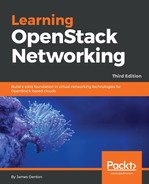A security group is a collection of network access rules known as security group rules that limit the types of traffic an instance can send or receive. When an iptables-based driver is used, security group rules are converted to iptables rules that are applied on the compute nodes hosting the instances. Each OpenStack project is provided with a default security group that can be modified by users within the project. OpenStack Networking provides an API for creating, modifying, applying, and deleting security groups and rules.
There are multiple ways to apply security groups to instances. For example, one or more instances, usually of similar functionality or role, can be placed in a security group. Security group rules can reference IPv4 and IPv6 hosts and networks as well as other security groups. Referencing a particular security group in a rule, rather than a particular host or network, frees the user from having to specify individual network addresses. Neutron will construct the filtering rules applied to the host automatically based on information in the database.
Rules within a security group are applied at a port level on the compute node, as demonstrated in the following diagram:

In the preceding diagram, ports within the virtual switch belong to one of three security groups: WEB, DB, or APP. When a change is made to a security group, such as adding or removing rules to the group, corresponding iptables rule changes are made automatically on the compute nodes.
Some users may use security groups to describe certain types of rules that should be applied to a particular instance port. For example, a security group can be used to categorize multiple hosts or subnets that are allowed access to a port. Multiple security groups can be applied to a port, and all rules defined in those groups are applied to the port. Because all traffic is implicitly denied and security group rules define only allowed traffic through a port, there is no chance of a rule in one security group applied to a port counteracting a rule in another security group applied to the same port.
The following example demonstrates the use of security groups to categorize traffic that is allowed access through a port:

When a port is created in Neutron, it is associated with a default security group unless a specific security group is specified. The default security group drops all ingress traffic and allows all egress traffic from the associated port. Rules can be added to, or removed from, the default security group to change its behavior. In addition, baseline port security rules are applied to every port that prohibit IP, DHCP, and MAC address spoofing. This behavior can be changed and will be discussed later on in this chapter.
